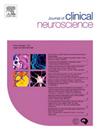Trans-arterial approach for neural recording and stimulation: Present and future
IF 1.9
4区 医学
Q3 CLINICAL NEUROLOGY
引用次数: 0
Abstract
Neural recording and stimulation are fundamental techniques used for brain computer interfaces (BCIs). BCIs have significant potential for use in a range of brain disorders. However, for most BCIs, electrode implantation requires invasive craniotomy procedures, which have a risk of infection, hematoma, and immune responses. Such drawbacks may limit the extensive application of BCIs. There has been a rapid increase in the development of endovascular technologies and devices. Indeed, in a clinical trial, stent electrodes have been endovascularly implanted via a venous approach and provided an effective endovascular BCI to help disabled patients. Several authors have reviewed the use of endovascular recordings or endovascular BCIs. However, there is limited information on the use of trans-arterial BCIs. Herein, we reviewed the literature on the use of trans-arterial neural recording and stimulation for BCIs, and discuss their potential in terms of anatomical features, device innovations, and clinical applications. Although the use of trans-arterial recording and stimulation in the brain remains challenging, we believe it has high potential for both scientists and physicians.
经动脉神经记录和刺激方法:现状与未来
神经记录和刺激是脑机接口(bci)的基本技术。脑机接口在一系列脑部疾病中具有巨大的应用潜力。然而,对于大多数脑机接口,电极植入需要侵入性开颅手术,这有感染、血肿和免疫反应的风险。这些缺点可能会限制脑机接口的广泛应用。血管内技术和设备的发展日新月异。事实上,在一项临床试验中,支架电极已通过静脉入路在血管内植入,并提供有效的血管内脑机接口来帮助残疾患者。几位作者回顾了血管内记录或血管内脑机接口的使用。然而,关于经动脉脑机接口的使用信息有限。在此,我们回顾了经动脉神经记录和刺激用于脑机接口的文献,并从解剖学特征、设备创新和临床应用方面讨论了它们的潜力。尽管在大脑中使用经动脉记录和刺激仍然具有挑战性,但我们相信它对科学家和医生都有很大的潜力。
本文章由计算机程序翻译,如有差异,请以英文原文为准。
求助全文
约1分钟内获得全文
求助全文
来源期刊

Journal of Clinical Neuroscience
医学-临床神经学
CiteScore
4.50
自引率
0.00%
发文量
402
审稿时长
40 days
期刊介绍:
This International journal, Journal of Clinical Neuroscience, publishes articles on clinical neurosurgery and neurology and the related neurosciences such as neuro-pathology, neuro-radiology, neuro-ophthalmology and neuro-physiology.
The journal has a broad International perspective, and emphasises the advances occurring in Asia, the Pacific Rim region, Europe and North America. The Journal acts as a focus for publication of major clinical and laboratory research, as well as publishing solicited manuscripts on specific subjects from experts, case reports and other information of interest to clinicians working in the clinical neurosciences.
 求助内容:
求助内容: 应助结果提醒方式:
应助结果提醒方式:


